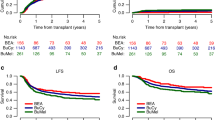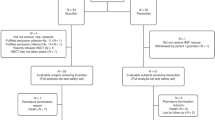Summary:
To reduce relapse following allogeneic transplantation for AML, intensification of high-dose busulfan/cyclophosphamide using additional agents has been investigated but with few reported comparisons. We compared an intensified regimen of etoposide (60 mg/kg), busulphan (14 mg/kg), and cyclophosphamide (120 mg/kg) (BuCyVP) with BuCy2 in 237 AML patients. No significant difference in overall outcome was observed following BuCyVP (n=127) or BuCy2 (n=110). The 5-year survival was 27.3 and 30.1% following BuCyVP and BuCy2, respectively (P=0.48). Similarly, the 5-year cumulative incidence of relapse (CIR) was 28.3 and 34.8% with BuCyVP and BuCy2 (P=0.45), respectively. On multivariable analysis, patients transplanted in CR1 (P=0.002) and from related donors (P=0.013) had longer survival, while disease status at transplant was the only factor predicting CIR (P=0.002). In a separate analysis of CR1 patients (n=56), there was no significant difference in survival (P=0.37) or CIR (P=0.87) between the two regimens. However, for more advanced disease, there was a trend towards less relapse with BuCyVP (P=0.08), which was balanced by a higher cumulative incidence of transplant-related deaths (P=0.03) compared to BuCy2, resulting in similar survival. Overall, our results do not support the use of the more intensive BuCyVP regimen over BuCy2 in either early or more advanced disease AML patients.
This is a preview of subscription content, access via your institution
Access options
Subscribe to this journal
Receive 12 print issues and online access
$259.00 per year
only $21.58 per issue
Buy this article
- Purchase on Springer Link
- Instant access to full article PDF
Prices may be subject to local taxes which are calculated during checkout




Similar content being viewed by others
References
Santos GW, Tutschka PJ, Brookmeyer R et al. Marrow transplantation for acute nonlymphocytic leukemia after treatment with busulfan and cyclophosphamide. N Engl J Med 1983; 309: 1347–1353.
Tutschka PJ, Copelan EA, Klein JP . Bone marrow transplantation for leukemia following a new busulfan and cyclophosphamide regimen. Blood 1987; 70: 1382–1388.
Copelan EA, Biggs JC, Thompson JM et al. Treatment for acute myelocytic leukemia with allogeneic bone marrow transplantation following preparation with BuCy2. Blood 1991; 78: 838–843.
Tutschka PJ . Use of busulfan containing chemotherapy for conditioning patients with leukemia for bone marrow allografting. Bone Marrow Transplant 1993; 12 (Suppl. 1): 34–36.
Devergie A, Blaise D, Attal M et al. Allogeneic bone marrow transplantation for chronic myeloid leukemia in first chronic phase: a randomized trial of busulfan–cytoxan vs cytoxan–total body irradiation as preparative regimen: a report from the French Society of Bone Marrow Graft (SFGM). Blood 1995; 85: 2263–2268.
Blume KG, Kopecky KJ, Henslee-Downey JP et al. A prospective randomized comparison of total body irradiation–etoposide vs busulfan–cyclophosphamide as preparatory regimens for bone marrow transplantation in patients with leukemia who were not in first remission: a Southwest Oncology Group study. Blood 1993; 81: 2187–2193.
Clift RA, Buckner CD, Thomas ED et al. Marrow transplantation for chronic myeloid leukemia: a randomized study comparing cyclophosphamide and total body irradiation with busulfan and cyclophosphamide. Blood 1994; 84: 2036–2043.
Geller RB, Saral R, Piantadosi S et al. Allogeneic bone marrow transplantation after high-dose busulfan and cyclophosphamide in patients with acute nonlymphocytic leukemia. Blood 1989; 73: 2209–2218.
Lynch MH, Petersen FB, Appelbaum FR et al. Phase II study of busulfan, cyclophosphamide and fractionated total body irradiation as a preparatory regimen for allogeneic bone marrow transplantation in patients with advanced myeloid malignancies. Bone Marrow Transplant 1995; 15: 59–64.
Hirabayashi N, Goto S, Ishii M et al. Busulfan, cyclophosphamide and total body irradiation as conditioning for allogeneic bone marrow transplantation for acute and chronic myeloid leukemia. Bone Marrow Transplant 1998; 21: 1079–1083.
Petersen FB, Buckner CD, Appelbaum FR et al. Busulfan, cyclophosphamide and fractionated total body irradiation as a preparatory regimen for marrow transplantation in patients with advanced hematological malignancies: a phase I study. Bone Marrow Transplant 1989; 4: 617–623.
Przepiorka D, Ippoliti C, Giralt S et al. A phase I-II study of high-dose thiotepa, busulfan and cyclophosphamide as a preparative regimen for allogeneic marrow transplantation. Bone Marrow Transplant 1994; 14: 449–453.
Rosales F, Naparstek E, Varadi G et al. The role of thiotepa in allogeneic stem cell transplantation in patients with leukemia. Leuk Res 1999; 23: 947–952.
Ratanatharathorn V, Karanes C, Lum LG et al. Allogeneic bone marrow transplantation in high-risk myeloid disorders using busulfan, cytosine arabinoside and cyclophosphamide (BAC). Bone Marrow Transplant 1992; 9: 49–55.
Nagatoshi Y, Okamura J, Ikuno Y et al. Therapeutic trial of intensified conditioning regimen with high-dose cytosine arabinoside, cyclophosphamide and either total body irradiation or busulfan followed by allogeneic bone marrow transplantation for myelodysplastic syndrome in children. Int J Hematol 1997; 65: 269–275.
Carpenter PA, Marshall GM, Giri N et al. Allogeneic bone marrow transplantation for children with acute lymphoblastic leukemia conditioned with busulfan, cyclophosphamide and melphalan. Bone Marrow Transplant 1996; 18: 489–494.
Zander AR, Culbert S, Jagannath S et al. High dose cyclophosphamide, BCNU, and VP-16 (CBV) as a conditioning regimen for allogeneic bone marrow transplantation for patients with acute leukemia. Cancer 1987; 59: 1083–1086.
Vaughan WP, Dennison JD, Reed EC et al. Improved results of allogeneic bone marrow transplantation for advanced hematologic malignancy using busulfan, cyclophosphamide and etoposide as cytoreductive and immunosuppressive therapy. Bone Marrow Transplant 1991; 8: 489–495.
Kroger N, Zabelina T, Sonnenberg S et al. Dose-dependent effect of etoposide in combination with busulfan plus cyclophosphamide as conditioning for stem cell transplantation in patients with acute myeloid leukemia. Bone Marrow Transplant 2000; 26: 711–716.
von Bueltzingsloewen A, Belanger R, Perreault C et al. Allogeneic bone marrow transplantation following busulfan–cyclophosphamide with or without etoposide conditioning regimen for patients with acute lymphoblastic leukaemia. Br J Haematol 1993; 85: 706–713.
Zander AR, Berger C, Kroger N et al. High dose chemotherapy with busulfan, cyclophosphamide, and etoposide as conditioning regimen for allogeneic bone marrow transplantation for patients with acute myeloid leukemia in first complete remission. Clin Cancer Res 1997; 3: 2671–2675.
Stadtmauer EA, Cassileth PA, Gale RP . Etoposide in leukemia, lymphoma and bone marrow transplantation. Leuk Res 1989; 13: 639–650.
Bensinger WI, Buckner CD, Clift RA et al. Phase I study of busulfan and cyclophosphamide in preparation for allogeneic marrow transplant for patients with multiple myeloma. J Clin Oncol 1992; 10: 1492–1497.
Schiller G, Nimer S, Vescio R et al. Phase I-II study of busulfan and cyclophosphamide conditioning for transplantation in advanced multiple myeloma. Bone Marrow Transplant 1994; 14: 131–136.
Copelan EA, Penza SL, Pohlman B et al. Autotransplantation following busulfan, etoposide and cyclophosphamide in patients with non-Hodgkin's lymphoma. Bone Marrow Transplant 2000; 25: 1243–1248.
Bennett JM, Catovsky D, Daniel MT et al. Proposed revised criteria for the classification of acute myeloid leukemia. A report of the French–American–British Cooperative Group. Ann Intern Med 1985; 103: 620–625.
Vardiman JW, Harris NL, Brunning RD . The World Health Organization (WHO) classification of the myeloid neoplasms. Blood 2002; 100: 2292–2302.
Kaplan EL, Meier P . Nonparametric estimation from incomplete observations. J Am Stat Assoc 1958; 53: 457–481.
Gray RJ . A class of k-sample tests for comparing the cumulative incidence of a competing risk. Ann Stat 1988; 16: 1141–1154.
Fine JP, Gray RJ . A proportional hazards model for the subdistribution of a competing risk. JASA 1999; 94: 496–509.
Gupta V, Lazarus HM, Keating A . Myeloablative conditioning regimens for AML allografts: 30 years later. Bone Marrow Transplant 2003; 32: 969–978.
Ljungman P, Hassan M, Bekassy AN et al. High busulfan concentrations are associated with increased transplant-related mortality in allogeneic bone marrow transplant patients. Bone Marrow Transplant 1997; 20: 909–913.
Dix SP, Wingard JR, Mullins RE et al. Association of busulfan area under the curve with veno-occlusive disease following BMT. Bone Marrow Transplant 1996; 17: 225–230.
Crilley P, Topolsky D, Styler MJ et al. Extramedullary toxicity of a conditioning regimen containing busulphan, cyclophosphamide and etoposide in 84 patients undergoing autologous and allogeneic bone marrow transplantation. Bone Marrow Transplant 1995; 15: 361–365.
Spitzer TR, Cottler-Fox M, Torrisi J et al. Escalating doses of etoposide with cyclophosphamide and fractionated total body irradiation or busulfan as conditioning for bone marrow transplantation. Bone Marrow Transplant 1989; 4: 559–565.
Jones RJ, Santos GW . New conditioning regimens for high risk marrow transplants. Bone Marrow Transplant 1989; 4 (Suppl. 4): 15–17.
Spitzer TR, Peters C, Ortlieb M et al. Etoposide in combination with cyclophosphamide and total body irradiation or busulfan as conditioning for marrow transplantation in adults and children. Int J Radiat Oncol Biol Phys 1994; 29: 39–44.
Clark PI, Slevin ML . The clinical pharmacology of etoposide and teniposide. Clin Pharmacokinet 1987; 12: 223–252.
Kroger N, Hoffknecht M, Hanel M et al. Busulfan, cyclophosphamide and etoposide as high-dose conditioning therapy in patients with malignant lymphoma and prior dose-limiting radiation therapy. Bone Marrow Transplant 1998; 21: 1171–1175.
Przepiorka D, Dimopoulos M, Smith T et al. Thiotepa, busulfan, and cyclophosphamide as a preparative regimen for marrow transplantation: risk factors for early regimen-related toxicity. Ann Hematol 1994; 68: 183–188.
Author information
Authors and Affiliations
Corresponding author
Rights and permissions
About this article
Cite this article
Farag, S., Bolwell, B., Elder, P. et al. High-dose busulfan, cyclophosphamide, and etoposide does not improve outcome of allogeneic stem cell transplantation compared to BuCy2 in patients with acute myeloid leukemia. Bone Marrow Transplant 35, 653–661 (2005). https://doi.org/10.1038/sj.bmt.1704867
Received:
Accepted:
Published:
Issue Date:
DOI: https://doi.org/10.1038/sj.bmt.1704867
Keywords
This article is cited by
-
Myeloablative conditioning regimens in adult patients with acute myeloid leukemia undergoing allogeneic hematopoietic stem cell transplantation in complete remission: a systematic review and network meta-analysis
Bone Marrow Transplantation (2023)
-
A multicenter trial of myeloablative clofarabine and busulfan conditioning for relapsed or primary induction failure AML not in remission at the time of allogeneic hematopoietic stem cell transplantation
Bone Marrow Transplantation (2017)
-
High-dose etoposide in allogeneic stem cell transplantation
Cancer Chemotherapy and Pharmacology (2012)
-
Long-term outcomes in patients with high-risk myeloid malignancies following matched related donor hematopoietic cell transplantation with myeloablative conditioning of BU, etoposide and CY
Bone Marrow Transplantation (2011)
-
Elevated lactate dehydrogenase is an adverse predictor of outcome in HLA-matched sibling bone marrow transplant for acute myelogenous leukemia
Bone Marrow Transplantation (2007)



